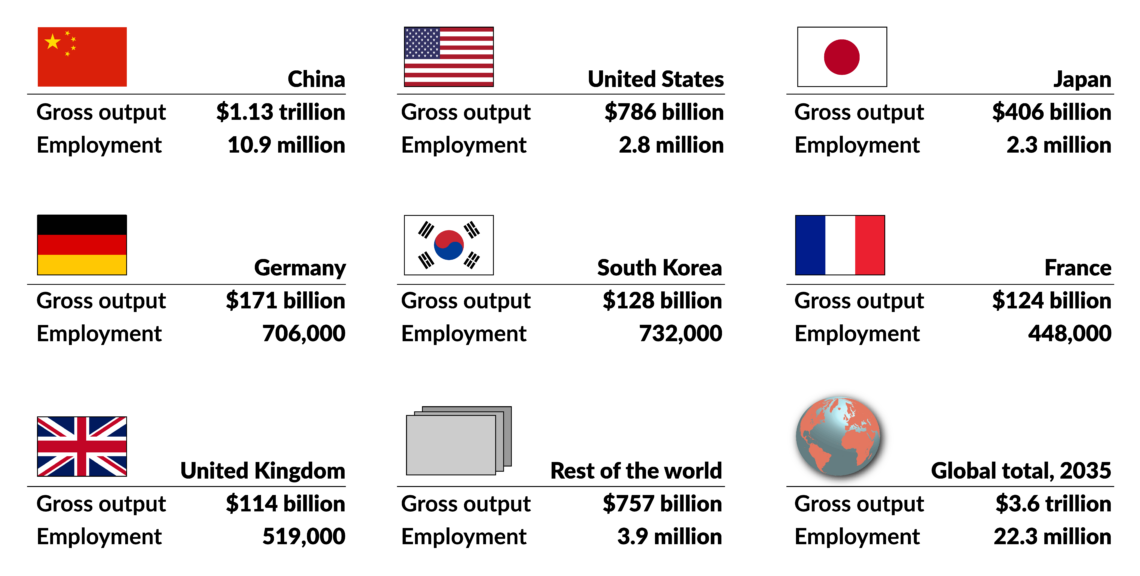U.S.-China 5G battle portends a divided internet
The USA and China are engaged in tit-for-tat threats over 5G. The stakes are high, since the technology will shape the future in unpredictable ways, and the competition will determine the technical infrastructure of modern governance.

In a nutshell
- The 5G competition will decide who shapes the economic order
- The U.S. and China will use 5G to push geopolitical goals
- The internet could fracture into competing spheres of influence
The United States Commerce Department recently amended its direct product rule to limit China’s Huawei Technologies’ access to advanced microprocessors – chipsets that are critical to virtually all of the company’s equipment and services.
The U.S. agency also indicated it would not grant Huawei another 90-day general license extension, further limiting the company’s access to American products and services. These actions are the latest escalation in the confrontation between Washington and Beijing over fifth generation (5G) wireless networks.
China is responding with threats to place Apple, Boeing, and other U.S. firms on its own “unreliable entities list,” which would constrain their business in China and likely be followed by monopoly and cybersecurity investigations. Many business and political leaders in the U.S., China and elsewhere believe both nations are recklessly endangering the global telecommunications market and the broader geopolitical relationship. Certainly, each country has a lot to lose if relations worsen. What, then, justifies this 5G brinkmanship?
This geopolitical competition over 5G will determine who shapes the fundamentals of the new economic order.
Put simply, this geopolitical competition over 5G will determine who shapes the fundamentals of the new economic order and who builds the technical infrastructure of modern governance.
Central nervous system
An IHS Markit study estimates 5G will create more than $13 trillion in new economic value by 2035, and that it will create more than 22 million jobs in the 5G global value chain alone. The applications of the technology go far beyond faster phones. The fundamental value proposition of 5G is that it promises decisive improvements in five key areas: mobile broadband, ultra-reliable low latency communications, massive machine-type communications, power efficiency and security. These improvements, realized in unison, will create networks that finally have the capacity to generate, process, move, store and secure the data of a truly connected world – and to reap the benefits of this world.
For example, before the deployment of 4G and 4G/LTE, wireless networks could not process data fast enough to allow services like Uber or Lyft. But, once deployed, these networks allowed real-time tracking of individuals’ and drivers’ locations, at scale. That gave rise to a “sharing economy” that is currently projected to be worth $335 billion by 2025. The performance gains from 4G to 5G dwarf those experienced between 3G and 4G: we simply have not yet imagined many of the innovations that will follow.
Facts & figures

Beyond the innovations themselves, these networks will also finally enable the “Internet of Things,” a world where the internet is no longer a place to visit, but an ever-present reality that is taken for granted – much like air conditioning when walking into a modern office building. Most appliances will generate data and insights. Artificial intelligence (AI) will then utilize this data to predict user needs, to find more efficient operations, to combine new and old information for novel applications and to enable data-heavy innovations like autonomous travel. This data-rich environment will likely generate even more sophisticated AI algorithms that will further expand the opportunities and capacities of individuals, societies and governments.
Technical foundation
The U.S. and China offer competing models of governance and both recognize 5G’s ability to further their respective visions. The U.S. prioritizes free-market capitalism and sees 5G as a way to enable a new epoch of American technological leadership that advances human economic and political progress domestically and around the world.
China, on the other hand, understands next-generation wireless networks as essential for realizing its vision of governance, where state-run capitalism is combined with technologically enabled authoritarianism. Both intend to export their respective models to like-minded nations.
The interconnected world of 5G, with its many promises, also comes laden with threats. Defending nations means defending networks, and defending networks means paying attention to who builds them. The point is even more crucial when all these networks connect with one another. These concerns are at the heart of U.S. restrictions on Huawei, which has been linked to China’s intelligence services.
The outcome of the 5G race will set the conditions for other equally consequential technology struggles.
The outcome of the 5G race will set the conditions for other equally consequential technology struggles between the U.S. and China – such as robotics, autonomous vehicles and advanced manufacturing. Washington and Beijing know this and are competing accordingly. The outcome of this competition, however, is far from clear.
There are three main scenarios for how this competition may turn out in the mid- to long-term.
Scenarios
First, China could dominate the global 5G market. The U.S. is making clear that it will not allow Chinese companies to build its domestic 5G networks. However, American capacity to convince other nations to follow suit has been limited and Huawei already has one-third of all global 5G handsets. To date, more than 35 nations have inked 5G agreements with Huawei, including key U.S. allies: the United Kingdom, France, Germany and Italy. While some speculate that Beijing’s missteps during the Covid-19 crisis will reverse some of these decisions, countries have not yet made any formal policy changes.
It is also true that Huawei is the only company that can unilaterally develop, deploy and manage an entire 5G network. Telecommunication companies Nokia and Ericsson have alternative offerings, but much of their supply chain remains in China. Neither company can compete with Huawei’s artificially depressed prices – often about a third of the cost of Nokia and Ericsson – due to China’s heavy government subsidies. No U.S. company is building global 5G networks.
A Chinese-dominated 5G market is a medium-probability, high-impact scenario because it is likely that China’s telecommunications lead will not be overcome in the near to medium term. That is not to say, however, that this leadership is unassailable in the long term.
A second scenario would be for the United States to rally and reassert itself. Historically, first movers have enjoyed significant advantages when shifting between wireless generations. This is because they gain billions in revenue, spur new job creation and set the standards and practices for all who follow. Even so, on occasion, late entrants can be opportunistic and can position themselves for future leadership – and the U.S. has done this before.
Europe, led by Germany, held the competitive advantage in 2G, allowing Ericsson and Nokia to field better devices and to transition to 3G in the 2000s while the U.S. was still rolling out 2G. But regulations hamstrung these companies and Japan assumed leadership of 3G. The United States eventually caught up with Japan, but it took years and the costs were significant. However, because of these investments, the U.S. had a head start on 4G and has dominated this latest generation of wireless networks. Unfortunately, this leadership has waned and much of the Western world is now playing catch-up with China.
While Washington is actively looking for alternatives and is trying to slow China’s 5G advancement, it may simply be too little too late, making this a medium-probability, high-impact scenario.
A third scenario is perhaps the most likely, but it is also the most disruptive and concerning. Global wireless networks, and therefore the internet itself, could fracture into competing spheres of influence.
As noted above, Washington and Beijing have two different notions of modern governance, but both understand networks as being critical for securing and spreading those visions. In much the same way that the world was divided into competing spheres of influence between the West and the Soviet Union during the Cold War, the world’s networks may soon be divided between a Western and Chinese internet – each with its own norms, rules and infrastructure. China, Russia and others are already building regional internets in the name of cybersecurity. There is little the U.S. can do to prevent these efforts from maturing.
American bans on Chinese companies like ZTE and Huawei are being mirrored by Chinese bans on Western equipment. These telltale signs can rightly be understood as hallmarks of the new “splinternet.”
The 5G competition between the U.S. and China has roots and implications reaching far beyond mobile phones. Both Washington and Beijing are signaling their commitment to winning this contest. No matter the outcome, significant global change is occurring, and it will all be streamed by our mobile devices.







